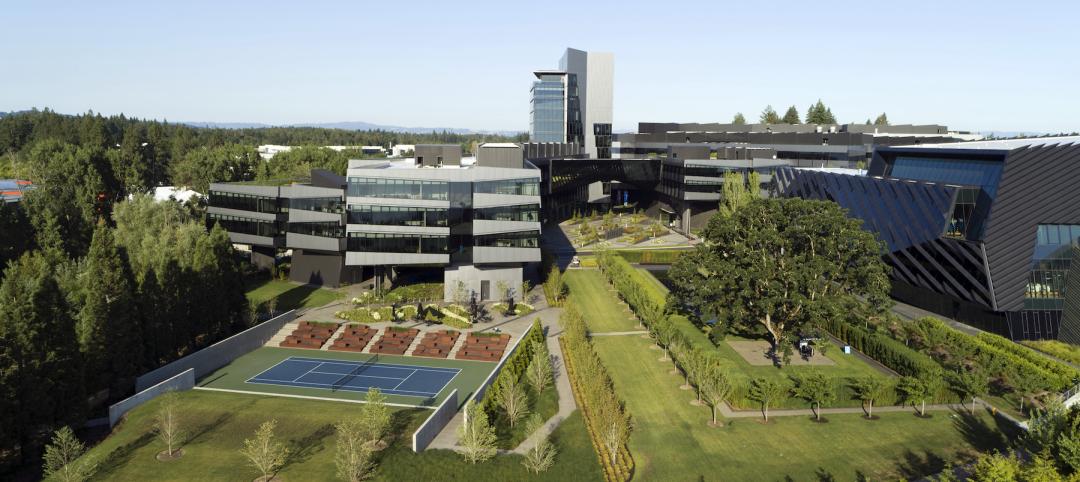There is one thing that every sailor in the U.S. Navy shares with every other sailor: For the first eight weeks of their Navy careers, every one of them will have gone through basic training at Camp John Paul Jones, Naval Station Great Lakes, in North Chicago, Illinois. Every year, more than 40,000 young men and women graduate from the Recruit Training Camp, en route to assignments around the world.
For the last three years or so, recruits have spent a considerable amount of their boot camp training in the Atlantic Fleet Drill Hall, a 56,840-sf facility designed by Wight & Company, Darien, Ill., that achieved LEED-NC v2.2 Gold, the first Navy construction project to earn that award. Recently, I was given a tour of the facility by Lt. Vincent Dasta, USN, Atlantic Fleet Commander, to inspect the sustainable aspects of the project.
The Navy, through its construction arm, the Naval Facilities Engineering Command (NAVFAC), was an early leader in green building among Federal departments. In fact, the Bachelor Enlisted Quarters at the Great Lakes Naval Training Center (also designed by Wight) was the first U.S. government project to be LEED certified, earning LEED-NC v1.0 Bronze in 2000—practically at the birth of LEED. Currently, the Navy requires all applicable projects to achieve a minimum LEED Silver rating.
Construction of the drill hall was part of a large-scale plan to modernize and upgrade facilities at Camp John Paul Jones, according to Dasta. “When we reorganized the base, this building fit in really well,” says Dasta. “This is the headquarters of the Atlantic Fleet, and we try to simulate to the recruits what the Fleet Navy is like.” Instead of using the term “barracks” for living quarters, the camp is divided into five “ships,” and the entry to the drill hall is known as the quarterdeck.
The massive drill hall itself is “a big, open space, very flexible, but the details make it useful to us,” says Dasta. It is used for physical training, drill exercises, and weekly Olympic-style sports competitions. The recruits are assigned to 14 divisions of 88 sailors; the drill hall can hold 10 divisions comfortably for marching exercises, says Dasta, but it can handle the full complement of divisions.
One of the major uses of the space is for running, and the resilient floor provides a pliant surface to reduce stress on recruits’ knees. The runners’ direction is reversed every day to keep the floor from developing a wear pattern. The facility is open 24/7, so it gets a great deal of use.
Dasta says the drill hall’s combined daylighting, lighting control, and shade control system has worked well over the last three years to keep the facility at a comfortable temperature while providing the health benefits associated with sunlight. Elsewhere in the drill hall are offices, a conference room, and classrooms.
Maintaining the building has been easy, according to Dasta. “Sustainment of facilities has become a big push in the last year or so, with the completion of the last of our major buildings” at Camp John Paul Jones.
The LEED Gold rating was achieved while conforming to the Navy’s Base Exterior Architectural Plan, which provides guidelines for upgrading the overall appearance of Navy shore facilities.
Key LEED milestones: a 41.7% reduction in water use and a 37.2% reduction in energy over a conventionally designed building. High-efficiency air-cooled water chillers with non-CFC refrigerant, energy recovery coils, and a direct digital control system for operator-programmable systems were employed, as well as occupancy sensors and scheduling to control outdoor air. The Building Team even anticipated the U.S. Green Building Council’s requirement for data collection on LEED projects by installing meters in the drill hall.
Other green elements: a solar white standing-seam metal roof, a motorized window shading system to control heat gain, and a five-year maintenance program for building operations, maintenance, and repairs.
The joint venture contractor of Pacific Construction Services and Old Veteran Construction Services Inc. (the latter a “service-disabled, veteran-owned” business) achieved an 89.6% rate of diversion of construction waste from landfill.
“We used a lot of smart conventional equipment to achieve the goals for the project,” says Lois Vitt Sale, AIA, LEED Faculty, and SVP/Chief Sustainability Officer at Wight & Company. BD+C
Low-impact Development Guides Stormwater Plan
Site planning for the Atlantic Fleet Drill Hall at Naval Station Great Lakes utilized the concept of low-impact development, or LID, to control stormwater runoff.
According to Tom Powers, PE, LEED AP, CRM, CPESC, a project manager with Wight, the basic principle of low-impact development is to model stormwater systems after nature—to manage rainfall at the source, using distributed small-scale stormwater management systems.
The goal, says Powers, is to “mimic the site’s hydrology as it existed before development began, using stormwater features that infiltrate, filter, store, evaporate, and detain runoff close to its source,” with particular attention to smaller, more frequent storms. Major infrastructure improvements at Camp John Paul Jones were designed to handle the much larger 100-year storms.
Since December 2007, with the passage of the Energy Independence and Security Act, controlling runoff is not a choice in almost all Federal construction projects. EISA states that “any development or redevelopment project involving a Federal facility with a footprint that exceeds 5,000 sf shall use site planning, design construction, and maintenance strategies for the property to maintain, or restore, to the maximum extent technically feasible, the predevelopment hydrology of the property with regard to the temperature, rate, volume, and duration of flow.” That pretty much mandates low-impact development for Federal projects.
The strategy for the Atlantic Fleet Drill Hall site had three prongs: 1) disconnect impervious areas where possible; 2) filter and infiltrate the average annual runoff; and 3) reduce nonpoint runoff through the use of native plantings.
The drill hall is situated on top of a small hill, with the building itself representing the largest source of concentrated stormwater runoff on the site. Under LID principles, the stormwater treatment areas were also located close to the building. The drill hall does not have a basement, so it was possible to excavate below-grade infiltration zones around the four corners of the building and fill them with gap-graded stone to create catchment basins with a 40% void ratio.
According to Powers, the roof runoff is then piped into the upper-layer infiltration zones and the water is allowed to percolate down through the stone following the groundwater gradient. The stormwater is daylighted and discharged to the infiltration zones via perforated pipes connected to the downspouts. The underground catchments are designed to hold a one-year 24-hour storm event and most of a two-year event; any spillover gets directed into the regional system and ultimately into the base detention facility.
For the bulk of the site, says Powers, the landscaping choice was to go with native plantings and buffalo grass, whose root systems can extend as far as eight feet deep into the soil, as opposed to only a few inches for Kentucky bluegrass. Buffalo grass needs only a quarter-inch of water per week and does not require mowing, pesticides, or fertilizers. Not having to irrigate the buffalo grass and other native decorative plantings contributed to the 41.7% reduction in water use for the drill hall compared to a conventional project. Moreover, buffalo grass grows to a maximum height of about five inches in the Great Lakes region and therefore does not present a security problem, which is important in a military facility.
Without the LID plan, the one-acre site would have had an unrestricted runoff rate of 6-7 cfs, says Powers. With LID, that has been reduced to 1.77 cfs for a one-year 24-hour storm and 2.03 cfs for a two-year storm. “We captured all the one-year storms and 99% of the two-year storms, and that’s before you count in the benefit of the buffalo grass,” says Powers.
Related Stories
Codes and Standards | Aug 3, 2022
Some climate models underestimate risk of future floods
Commonly used climate models may be significantly underestimating the risk of floods this century, according to a new study by Yale researchers.
| Aug 3, 2022
Designing learning environments to support the future of equitable health care
While the shortage of rural health care practitioners was a concern before the COVID-19 pandemic, the public health crisis has highlighted the importance of health equity in the United States and the desperate need for practitioners help meet the needs of patients in vulnerable rural communities.
Reconstruction & Renovation | Aug 3, 2022
Chicago proposes three options for Soldier Field renovation including domed stadium
The City of Chicago recently announced design concepts for renovations to Soldier Field, the home of the NFL’s Chicago Bears.
Codes and Standards | Aug 2, 2022
New tools help LEED projects reach health goals
The U.S. Green Building Council now offers tools to support the LEED Integrative Process for Health Promotion (IPHP) pilot credit.
Market Data | Aug 2, 2022
Nonresidential construction spending falls 0.5% in June, says ABC
National nonresidential construction spending was down by 0.5% in June, according to an Associated Builders and Contractors analysis of data published today by the U.S. Census Bureau.
K-12 Schools | Aug 1, 2022
Achieving a net-zero K-12 facility is a team effort
Designing a net-zero energy building is always a challenge, but renovating an existing school and applying for grants to make the project happen is another challenge entirely.
Healthcare Facilities | Aug 1, 2022
New Phoenix VA outpatient clinic is one of the largest veteran care facilities in the U.S.
The new Phoenix 32nd Street VA Clinic, spanning roughly 275,000 sf over 15 acres, is one of the largest veteran care facilities in the U.S.
Codes and Standards | Jul 29, 2022
Few projects and properties are being built beyond code
Clients and architects disagree on how well building to code provides resilience, according to a recent report by the American Institute of Architects (AIA) in partnership with Owens Corning.
Headquarters | Jul 29, 2022
Nike HQ’s newest, largest structure: the Serena Williams Building
In Beaverton, Ore., the new Serena Williams Building, at just over 1 million square feet, is the largest structure at Nike World Headquarters.
| Jul 28, 2022
Fanning Howey hires Dennis Bane, AIA, as Project Executive
Fanning Howey, an architecture, interiors and engineering firm specializing in learning environments, has hired Dennis Bane, AIA, ALEP, to serve as a Project Executive for the firm’s Indianapolis office.

















